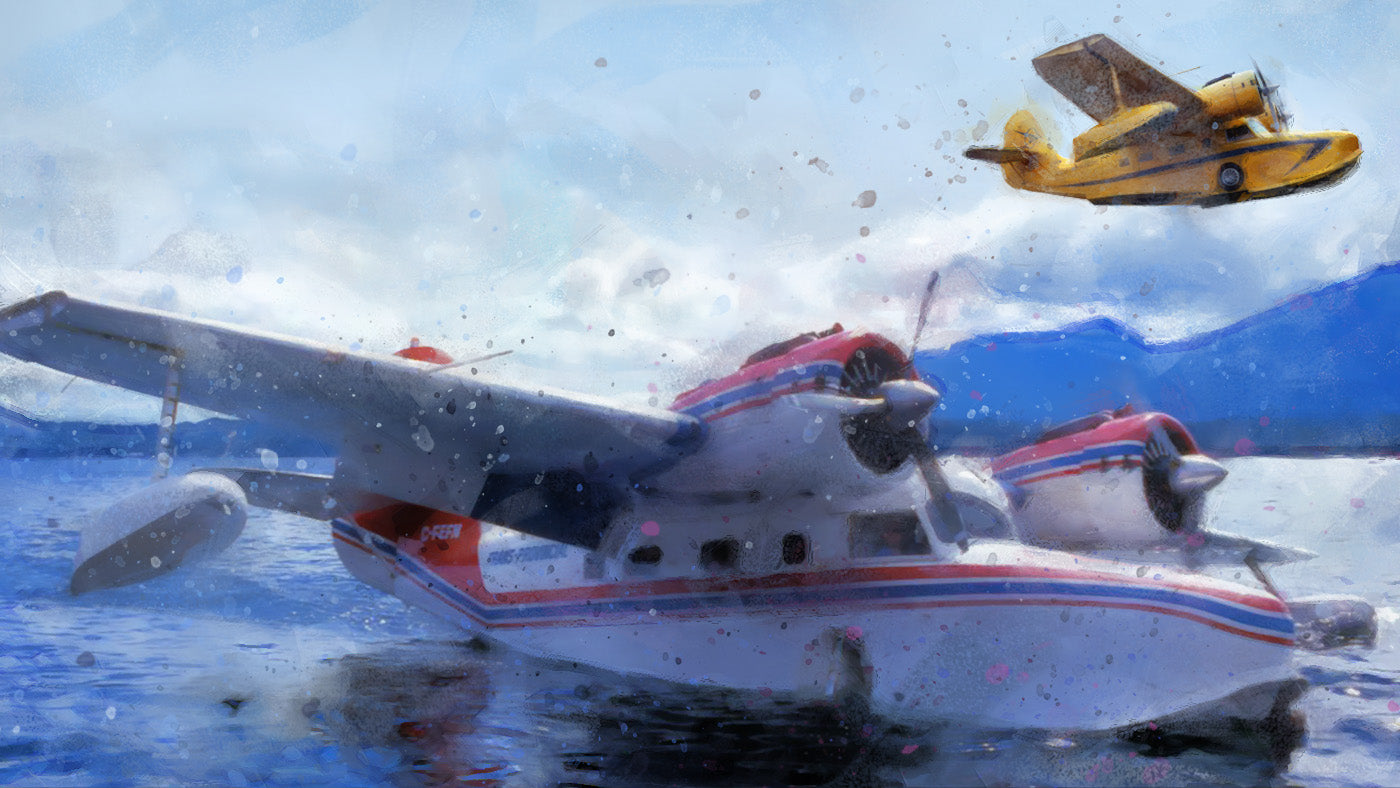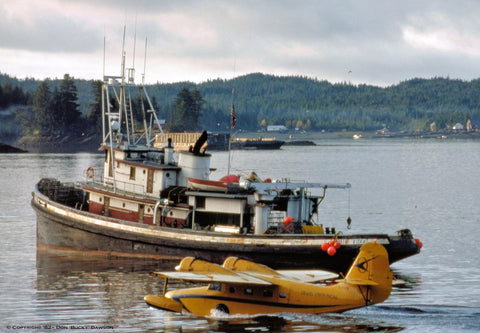
- by Dianna Lopez
Grumman G-21A Goose: A Legend of Sea and Sky
- by Dianna Lopez
A question? Visit our contact page
This site uses cookies for better user experience and analytics.

The Grumman G-21A Goose is an amphibious aircraft that has stood the test of time and the harsh elements of saltwater, snow and cold. Meet one Goose that survived a war and decades of flights through Alaska and the British Columbia coast and is now being restored - N88821.

The Grumman G-21 Goose was an American-made amphibious aircraft manufactured by Grumman Aviation between 1937 and 1945. It was Grumman’s first twin-engine plane, first monoplane to fly, and its first plane to be used as a commercial airliner. The Goose was capable of ascension from land or sea, and proved to be a versatile and sturdy design. Although it was initially imagined as a commuter aircraft for wealthy New Yorkers, it later found its identity in other uses, namely as a military transport and utility aircraft during World War II. After the war, its versatility gave it new life with small local airlines in Alaska, California and the Caribbean. 345 G-21s were produced.

While the team at Grumman was busy designing an amphibious aircraft which would later become the Goose, another team of ten wealthy businessmen were also busy looking for a private aircraft to suit their particular needs. Businessman Wilton Lloyd-Smith and his syndicate of business and sportsmen all lived on waterfront estates in Long Island and required an amphibious commuter seaplane to ferry them between the Wall Street waterfront in Manhattan and Long Island. They consulted with Grover Loening who had previously designed the Air Yacht, a civilian amphibian aircraft. Since then, Loening had sold his company and was now an investor and consultant to Grumman Aircraft. He reviewed the syndicate’s requirements and created a design for a high-wing, twin-engine amphibious plane. He recommended Grumman to build the aircraft and the Goose was born. The G-21 prototype first flew in May 1937, and the first G-21A Goose was sold to Lloyd-Smith the following month for $60,000.
Other members of the group of businessmen who also ordered Goose included:

The Grumman Aircraft Engineering Corporation, later Grumman Aerospace Corporation, was a chief 20th century producer of military and civilian aircraft. in the U.S. It was founded on December 6, 1929, by Leroy Grumman and his partners. In 1969, the company changed its name to Grumman Aerospace Corporation. In 1994, it merged with Northrop Corporation to form Northrop Grumman.
Grumman's World War II production, ranked 22nd in value of wartime production contracts, beginning with the G-21 Goose in 1937 included many prototype and mass produced aircraft:


Performance:
Military Designations:

C/N 1157 was the 157th of 345 Gooses built. It rolled out of the Grumman Aircraft plant, known as the Iron Works, in Bethpage, New York in December 1942. Originally built in a Lend-Lease production run, it was diverted and delivered instead to the U.S Army Air Force.
Assigned to the 6th Air Force during WWII, it was used for military attache liaison transportation in the Caribbean Sector, Cuba, Guatemala, and Venezuela. During WWII, Gooses were used for transport, patrol, target towing, training, and photography, as well as air and sea rescue. Only the U.S. Navy JRF-4 carried armament. They could accommodate a crew of 2 to 3 and around 7 passengers. It is the only surviving WWII Army Air Force OA-9 Goose in existence.

At war’s end in 1945, many of the surviving Gooses went on to serve with small airlines and as bush planes. Our plane was acquired from War Assets/Reconstruction Finance Corporation by Ellis Air Lines, owned and operated by bush pilot and legend Bob Ellis. N88821 was the first of ten Gooses operated by EAL, and one of three that was refitted as a straight flying boat for water-only operations. ‘821 got its wheels back. After it was bought by Alaska Airlines in 1968, the Gooses began phasing out.


Courtesy of Airline Timetable Images
Beginning in 1936, EAL operated in southeastern Alaska, later merging with Alaska Coastal Airlines in 1962 to become Alaska Coastal Ellis Airlines, which was later taken over by Alaska Airlines six years later. After the merger in 1962, the company became the world’s largest scheduled amphibian airline.

Courtesy of Airline Timetable Images

In 1972, after changing hands several times in various states of assembly, it was exported to Canada and returned to an airworthy state by Nils Christensen/Viking Air Ltd. It was reregistered as C-FEFN and began flying the British Columbia coast, logging over 34 thousand flight hours over almost 50 years of salt water operations. It was finally retired, a well deserved rest, in 1991 after a ground-loop landing accident. In October 1992, the plane returned to what had been its longtime home in Ketchikan, Alaska, to be restored as a static museum display.

MotoArt owner Dave Hall had the opportunity to meet Don “Bucky” Dawson at the 2021 Reno Air Races and hear about the restoration of N88821. "The Grumman Goose is an amazing - and extremely rare - aircraft,” says Hall. “We didn’t think twice about collaborating with this restoration project.”
Instead of sending the team to a boneyard to acquire the original aircraft skin material, Dawson send the pieces to MotoArt. Here are just a couple of the sections - note the careful notations from the restoration.



In 1989, Tongass Historical Society in Ketchikan, Alaska became the sponsor organization for the restoration of N88821. Spearheaded by Don Dawson, the project is restoring the aircraft, which was first brought to the area in 1945 and, as an Ellis Air Lines Goose, became a part of the scenery and history of Ketchikan itself. Read more about the restoration and how you can help here.



The Goose PlaneTags are numbered in a series of 5,000 and will be released with the following variants: Metal, Green and White. They join the other esteemed planes in the fleet that have come from restoration projects. "Not only are we trying to fill our encyclopedia of air and spacecraft," says Dave Hall. "But we also support restoration projects like the Goose, and the efforts to preserve its incredible history." This Goose lived a full and exciting life and the G-21A PlaneTags will be appreciated by aviation and history enthusiasts alike. They are available now at planetags.com.

We have had the privilege of honoring other aircraft manufactured by Grumman, including the Gulfstream G-II PlaneTags and the Grumman HU-16 Albatross PlaneTags. If you’re a fan of Grumman or our other flying boat PlaneTags don’t miss out on adding a Goose to your collection before they sell out.

MotoArt has featured some of Grumman’s iconic aircraft in our furniture, including the Albatross Aileron Conference Table. Let us make a one-of-a-kind aviation desk or conference for you.
From Warbird to Water Bomber: The Epic Life of the Hawaii Mars
In the world of aviation, few aircraft have lived a life as large, or as long, as the Hawaii Mars. Towering over most of its contemporaries with a wingspan of 200 feet, this mighty flying boat was born in the final days of World War II, then quietly transformed into one of the most iconic aerial firefighting aircraft the world has ever seen. From military transport to firefighting titan, the Hawaii Mars represents one of aviation’s most extraordinary second acts.
In 2025, MotoArt obtained an original wing of this aircraft and created special PlaneTags, made exclusively for the Martin family members and Mars workers. On December 11, 2025, Hawaii Mars PlaneTags will be available to the general public for the first time.
F-14 Tomcat Coasters: A Legendary Fighter Reimagined for Your Home
Few aircraft define an era quite like the Grumman F-14 Tomcat. Sleek, powerful, and unmistakably iconic, the Tomcat was the Navy’s premier fleet defense fighter for more than three decades. From Cold War missions to pop culture stardom, the F-14 remains one of the most recognizable and beloved aircraft ever built. Today, MotoArt is proud to introduce the F-14 Tomcat Coaster Set, created from authentic F-14 aircraft material.
PR-AJB: The Story of an Azul Airbus A320 With a Global Journey
Every airplane has a story, and some travel farther than others before their flying days are over. PR-AJB was one of those well-traveled aircraft. This Airbus A320 started its life flying British families on long-awaited holidays, then later crossed the Atlantic to join the growing fleet of Azul Linhas Aéreas Brasileiras. Over nearly nineteen years it picked up new registrations, new paint, new routes and a new home, carrying thousands of passengers along the way.
Its journey reflects how widely the A320 family has spread around the world and how easily these aircraft adapt to whatever their next chapter requires. PR-AJB also arrived at Azul during an important period of expansion as the airline worked to connect more cities across Brazil. In this blog we will explore where the aircraft came from, what it did during its short time with Azul, and how it eventually came to rest in Florida. We will also share how MotoArt recovered material from the retired airframe and created PlaneTags so its story can continue in a new way.


Share:
Convair 990: A Legacy of Speed
Air Transat A310: A Final Flight of Mercy